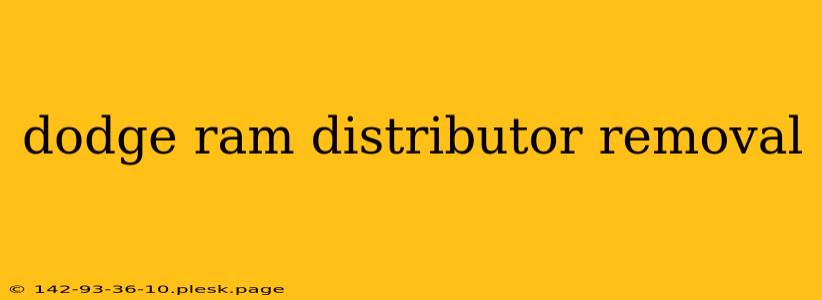Replacing a distributor on your Dodge Ram can seem daunting, but with the right tools and a methodical approach, it's a manageable task. This guide provides a step-by-step walkthrough, covering crucial points to ensure a smooth and successful distributor removal. Remember to always consult your vehicle's specific repair manual for detailed diagrams and torque specifications.
Tools You'll Need
Before you begin, gather the necessary tools. This will save you time and frustration during the process. You'll likely need:
- Socket wrench set: Various sizes will be necessary to remove bolts and nuts.
- Ratchet: A comfortable ratchet will make the process much easier.
- Screwdrivers: Both Phillips and flathead may be required, depending on your vehicle's year and model.
- Distributor removal tool: This specialized tool makes removing the distributor significantly easier and prevents damage. If unavailable, extreme caution must be used with alternative methods.
- Wrench for the distributor hold-down clamp: This will vary depending on your vehicle.
- Pliers: Helpful for disconnecting various components.
- Shop rags: To keep things clean and prevent damage from oil and grease.
- Marking tools: A pen or marker to note the rotor and distributor cap position for proper reinstallation.
Step-by-Step Distributor Removal Process
This process is a general guideline. Consult your vehicle's repair manual for precise details related to your specific Dodge Ram year and engine type.
1. Preparation is Key
- Disconnect the battery: This crucial safety step prevents accidental electrical shorts.
- Locate the distributor: It's typically located on the engine's top, near the spark plug wires.
- Mark the distributor's position: Carefully mark the rotor's position relative to the distributor cap and engine. This is essential for accurate reinstallation.
- Remove the distributor cap: Carefully lift off the distributor cap, noting the firing order of the spark plug wires. Take a photo if it aids your memory.
2. Disconnecting Components
- Disconnect the spark plug wires: Carefully remove each spark plug wire, making sure to note its position. Again, a photo is helpful.
- Disconnect the wiring harness: Locate the wiring harness connected to the distributor and carefully disconnect it.
- Remove the distributor hold-down clamp: Use the appropriate wrench to loosen and remove the clamp securing the distributor to the engine.
3. Removing the Distributor
- Use a distributor removal tool: If you have one, carefully insert it into the distributor and follow the manufacturer's instructions for removal. This is the safest and most effective method.
- Alternative method (Use with extreme caution): If you do not have a specialized tool, carefully try to rock the distributor back and forth while gently pulling upwards. Be mindful of not bending or damaging any components. This method is less ideal and can lead to damage if not done carefully.
4. Post-Removal Inspection
- Inspect the distributor: Once removed, thoroughly inspect the distributor for any signs of wear, damage, or defects. This will help in identifying the root cause of the problem.
- Clean the distributor mounting area: Clean the distributor mounting area on the engine block to ensure proper seating of the new distributor.
Reinstallation: Reverse the Process
Reinstallation is essentially the reverse of the removal process. Remember to meticulously align the rotor to the marked position to ensure correct timing. Incorrect alignment can lead to engine misfires and other serious issues.
Troubleshooting
If you encounter difficulties during the removal or reinstallation process, consult your vehicle's repair manual or seek assistance from a qualified mechanic.
This guide offers a general overview. Always prioritize safety and consult your vehicle's specific repair manual for year and engine-specific instructions. Remember, working on your vehicle involves inherent risks, and proceeding without proper knowledge can cause damage. If unsure about any step, consult a qualified mechanic.

